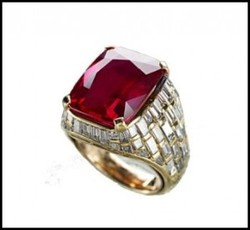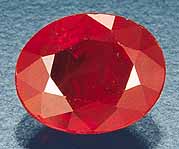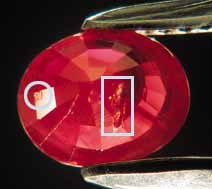
Ruby gems are not cheap, this also means that ruby gemstone jewelry can be quite expensive. This is what makes many jewelry buyers a bit nervous when buying a ruby gem or jewelry with ruby gemstones. So what exactly is a real ruby? You could say that a ruby gemstone that has been mined from the earth and not made in a factory is a 'real' ruby. this would be a very simplistic definition - other issues like treatments applied to the ruby would also be relevant.
A ruby like any other gem stone is almost always treated in some way or the other to enhance it's beauty. The treatment enhances the color and/or the clarity of the gemstone. Contrary to what many gem and jewelry lovers believe, ruby treatment is not a new practice, it has been done for many decades now. The earliest form of treating a ruby gem stone was to heat the gemstone to a high temperature, this caused impurities in the gemstone to evaporate and also enhanced the reddish color of the ruby gemstone.
This is the conventional heating process used to treat rubies. When a ruby gem stone is heated in this way, the hardness and durability of the gem remains intact. Conventional heating also brings about a permanent change in the appearance of the ruby that is heated. The color is stable and the gem will not turn back to it's original color. This is a desirable effect of ruby gems that are conventionally heated. This treatment is accepted by all gem experts, gem and jewelry providers do not even care to mention that the rubies that they sell are heat treated. You can just take it for granted that they are always treated.The subsequent ruby treatments that were developed, involved heating but they did more than that to the gem. A technic was developed that became known as the 'fissure filling'treatment for ruby gemstones. This process developed in two stages of the fissure filled ruby treatment. In this treatment, the rubies are added to the oven with certain 'flux agents'. The effect of these additional ingredients into the oven, help to drop the melting point of the ruby gemstone. The rubies start to melt internally, the molten ruby seeps into any fissures or cracks that might be (naturally) present in the gem. The molten ruby then hardens on cooling and helps to 'fill' the cracks or 'heal' the cracks in the gemstone. This obviously increases the transparency of the gem and also it's beauty. The important thing is that this type of ruby treatment needs to be disclosed by the seller.
Moving deeper into the fissure filling process used to treat rubies, you will often come across the word 'glass filled rubies'. This is also basically a fissure filling process used to treat ruby gems but, some important details need to be understood. In this process the additional material added to the oven is composed of silica based compounds. On heating, the silica compounds become glass, flow into the cracks of the gem and fill them. This enhances the transparency of the ruby and makes it looks quite impressive. However what you need to know is that what you finally get is a ruby and glass existing side by side. Gem experts refer to this as a 'composite' gem as it combines ruby and glass. One of the negative features of glass filled rubies is that, they drastically reduce the toughness of the ruby. The physical properties of the treated ruby are altered, the gem is not stable. This treatment is applied to the lowest grade of ruby gems. It is the junk material that would otherwise have been discarded.
Natural unheated ruby was found in Africa in significant amounts in the mines of Tanzania as well as Mozambique – the Winza mine ruby of Tanzania and the Niassa ruby from Mozambique. The advantage that these two sources have is in terms of clarity and color. The counterparts from other mines in the same countries produce inferior grade marble type rubies.
I am certainly not an expert on this but I hope my exploring for information was helpful to you. I am also learnng along the way.


 RSS Feed
RSS Feed


